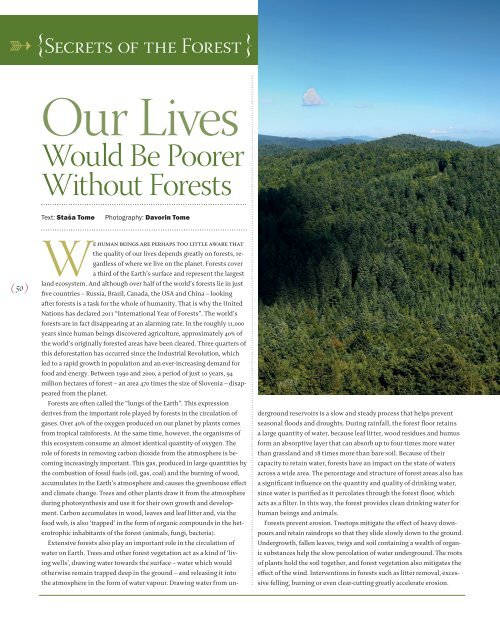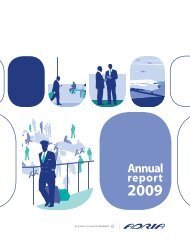Oktober, november 2011 - Adria Airways
Oktober, november 2011 - Adria Airways
Oktober, november 2011 - Adria Airways
- No tags were found...
Create successful ePaper yourself
Turn your PDF publications into a flip-book with our unique Google optimized e-Paper software.
{ Secrets of the Forest }Our LivesWould Be PoorerWithout ForestsText: Staša TomePhotography: Davorin Tome( 50 )We human beings are perhaps too little aware thatthe quality of our lives depends greatly on forests, regardlessof where we live on the planet. Forests covera third of the Earth’s surface and represent the largestland ecosystem. And although over half of the world’s forests lie in justfive countries – Russia, Brazil, Canada, the USA and China – lookingafter forests is a task for the whole of humanity. That is why the UnitedNations has declared <strong>2011</strong> “International Year of Forests”. The world’sforests are in fact disappearing at an alarming rate. In the roughly 11,000years since human beings discovered agriculture, approximately 40% ofthe world’s originally forested areas have been cleared. Three quarters ofthis deforestation has occurred since the Industrial Revolution, whichled to a rapid growth in population and an ever-increasing demand forfood and energy. Between 1990 and 2000, a period of just 10 years, 94million hectares of forest – an area 470 times the size of Slovenia – disappearedfrom the planet.Forests are often called the “lungs of the Earth”. This expressionderives from the important role played by forests in the circulation ofgases. Over 40% of the oxygen produced on our planet by plants comesfrom tropical rainforests. At the same time, however, the organisms ofthis ecosystem consume an almost identical quantity of oxygen. Therole of forests in removing carbon dioxide from the atmosphere is becomingincreasingly important. This gas, produced in large quantities bythe combustion of fossil fuels (oil, gas, coal) and the burning of wood,accumulates in the Earth’s atmosphere and causes the greenhouse effectand climate change. Trees and other plants draw it from the atmosphereduring photosynthesis and use it for their own growth and development.Carbon accumulates in wood, leaves and leaf litter and, via thefood web, is also ‘trapped’ in the form of organic compounds in the heterotrophicinhabitants of the forest (animals, fungi, bacteria).Extensive forests also play an important role in the circulation ofwater on Earth. Trees and other forest vegetation act as a kind of ‘livingwells’, drawing water towards the surface – water which wouldotherwise remain trapped deep in the ground – and releasing it intothe atmosphere in the form of water vapour. Drawing water from undergroundreservoirs is a slow and steady process that helps preventseasonal floods and droughts. During rainfall, the forest floor retainsa large quantity of water, because leaf litter, wood residues and humusform an absorptive layer that can absorb up to four times more waterthan grassland and 18 times more than bare soil. Because of theircapacity to retain water, forests have an impact on the state of watersacross a wide area. The percentage and structure of forest areas also hasa significant influence on the quantity and quality of drinking water,since water is purified as it percolates through the forest floor, whichacts as a filter. In this way, the forest provides clean drinking water forhuman beings and animals.Forests prevent erosion. Treetops mitigate the effect of heavy downpoursand retain raindrops so that they slide slowly down to the ground.Undergrowth, fallen leaves, twigs and soil containing a wealth of organicsubstances help the slow percolation of water underground. The rootsof plants hold the soil together, and forest vegetation also mitigates theeffect of the wind. Interventions in forests such as litter removal, excessivefelling, burning or even clear-cutting greatly accelerate erosion.
















